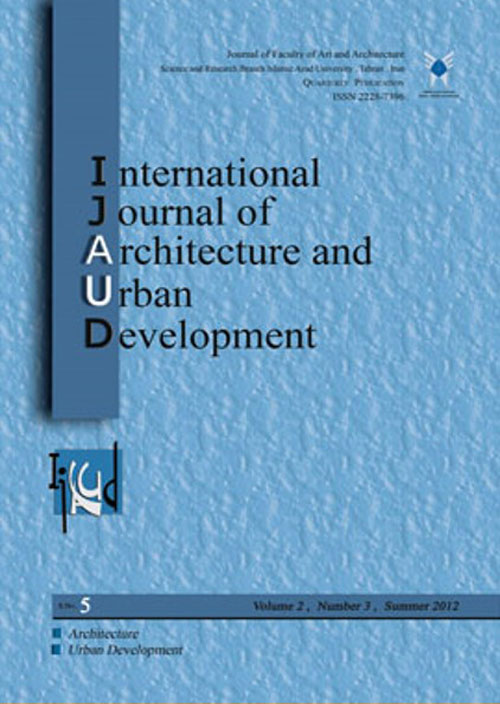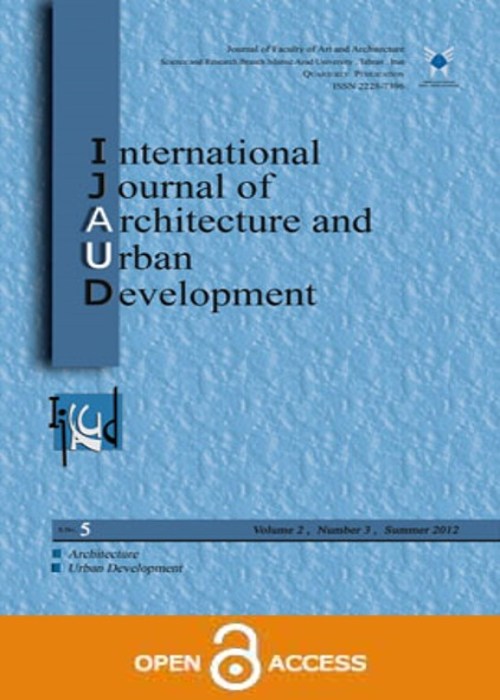فهرست مطالب

International Journal of Architecture and Urban Development
Volume:11 Issue: 3, Summer 2021
- تاریخ انتشار: 1400/04/20
- تعداد عناوین: 6
-
-
Pages 5-12
In the hospital environment, the complexity of the building configuration causes wayfinding difficulties for hospital users. This results in stress, anxiety, discomfort, loss of time, and missed appointments. This research establishes the critical factors that influence the ease of wayfinding in a hospital environment with consideration for the design systems. The study was carried out at Jos University Teaching Hospital, Plateau State, Nigeria. Also, a descriptive research design was employed with a survey questionnaire for data collection, administered on outpatients on a sample size of 96 respondents (48 males and 48 females), using a simple random sampling technique. Findings from factor analysis and multiple regressions showed that some factors have a high influence on the ease of wayfinding in the hospital environment concerning their loadings at significance value. These factors include landmarks, crowdedness in the circulation spaces, circulation intersection (nodes), and visual access. The study recommends that local landmarks should be designed to be visible from a distance at decision-making points in the hospital during wayfinding. Furthermore, circulation intersections (nodes or junctions) should be distinctive with directional signs and should have visible cues to reduce wayfinding errors at such decision points. This implies that spatial and visual factors should be considered in hospital wayfinding designs.
Keywords: Critical factors, Hospital environment, Wayfinding, Wayfinding system designs -
Pages 13-26
Various researches have introduced methods to use daylight in office buildings in the Middle East zone, but none of them have ever considered the use of plant leaf arrangement, called phyllotaxis, as a comprehensive solution for harvesting daylight. The idea of the Phyllotaxis Tower has been raised for several years but the main question of this research is whether using the phyllotaxis model is capable of exploiting daylight in high-rise buildings or not. So, in response to this question, the main aim of the research was set to evaluate daylight efficiency in high-rise office buildings by presenting an exemplary and phyllotaxis-inspired design. The research method is encompassed several steps including, studying the literature on the subject firstly, then modeling a prototype building based on the Biomimicry Problem-Based approach, and eventually computer simulation to evaluate the performance of the proposed building. The results show that office units can get daylight illuminance of 500 lux at 50% of operating time per year in addition to proper performance on four single days of different seasons of the year. Furthermore, the sample building obtained label B of energy consumption from Standard No. 14254 presented by the Institute of Standards and Industrial Research of Iran, which has been compared with the energy label of 45 office buildings in the same location and same climate conditions, based on the figures are defined on the aforementioned standard and has the best performance among them.
Keywords: Daylight, Energy efficiency, visual comfort, High-rise building, Phyllotaxis, Biomimicry -
Pages 27-38
One of the most important principles in the formation of Iranian-Islamic cities is the principle of unity. Observing the principle of unity in the physical-social space of historical neighborhoods has led to the organization and integration of them. A review of studies on this issue indicates that the principle of unity in the scale of urban neighborhoods has been less considered. The main question of the study is how and with what factors and criteria was the principle of unity formed in the physical space of Sarshoor neighborhood, Mashhad city? This study is historical and analytical research. The research process is divided into two main stages. In the first stage, it is attempted to determine how the spatial structure of the Sarshoor neighborhood was before the extensive physical-spatial interventions taken in the contemporary era. In the second stage, the factors and criteria related to the principle of unity are determined on the maps and photos of the neighborhood in an exploratory way and using the relevant graphical analysis. The results show that in the historical neighborhood of Sarshoor, a set of factors in a complex and close relationship with each other, have been effective in unifying the physical space of the neighborhood. Factors including "connectivity and continuity", "centrality", "hierarchy", "coordination", "interconnectedness" and "semantic unity" have been effective in realizing the principle of unity in the neighborhood by creating various qualities in different dimensions of physical space of the neighborhood.
Keywords: Unity, Diversity, Historical neighborhoods, Sarshoor neighborhood, Mashhad -
Pages 39-48
More than eight hundred years ago, before the invention of digital tools, Muslim builders had achieved the creative vision and aesthetic complexity required for the production of Muqarnas: an architectural device that connects surface ornament to divine concepts. This research adopts a qualitative, comparative, and critical use of architectural source material to construct an alternative understanding of Muqarnas within a documented history of architectural allegories and theories. The paper follows the argument that in the absence of figurative depiction in Islamic art, geometry assumes greater symbolic power, which manifests itself in ornament, structure, and space. In this system, Muqarnas uses complex geometry to connect wall surfaces to spacious volumes. In the metamorphosis of two-dimensional planes to three-dimensional space, Muqarnas occupies the in-between space that connects the two worlds in a smooth and parametric process of transition. Thus, Muqarnas operates similarly to the folds of Baroque architecture and expresses, in a mannerist, yet geometric manner, the connection between the two realms of body and soul. However, unlike the Deleuzian model of Baroque sacristy, light does not enter from below; from the realm of the body and the senses, but rather it shines from above; from the realm of the soul and divine concepts. From this point of view, Muqarnas becomes a significant phenomenon in architecture being a symbolic, ornamental, and parametric architectural device that simultaneously alludes to the allegories of the Platonic tradition, the Deleuzian concept of fold/unfold, and to recent theories of Parametricism
Keywords: Muqarnas, Ornament, Deleuze, Fold, Parametric Transition -
Pages 49-58
The urban landscape is an objective-subjective nature that plays a significant role in the perception of collective spaces by the audience. This is possible only by stimulating the perceptual potentials of users and inducing behavioral patterns to users of a space. This study investigates the role of urban landscaping in the perception of collective spaces using perceptual potentials. This research is descriptive-analytical and, in terms of purpose, is applied. A questionnaire did data collection, and for data analysis, Spearman and Friedman's statistical tests were used in SPSS software. A case study is the third square of Tehranpars, where the target community has also been selected as users of this space. In the data collected from the sample group, the highest level of correlation between the sub-components of objective aesthetics is the composition and color indices with a correlation coefficient of .857. Among the sub-components of subjective aesthetics, the penumbra indices and physical cohesion with a correlation coefficient of 0.690 have the highest level. In addition to the relationship between the proposed indices, the priority of these indices is ranked based on the Friedman test, and it is observed that the indices of composition (7.98), readability (5.89), and physical coherence (5.76) have the highest priority among the ranking of indices in terms of the statistical population. These data-driven priorities can identify design priorities and help take adequate steps to create a vitality urban space.
Keywords: Urban landscape, perception, perception of collective spaces, perceptual potentials, Third square ofTehranpars -
Pages 59-68
Industrialized Building has been introduced as a method with better productivity, quality, and safety, and it is defined as a construction system where components are manufactured at factories on or off-site, transported, and then assembled into with minimum work in the study of the use of building industrialization, the question of this study is to apply product-oriented and process-oriented in the quality of building industrialization and interaction and the overlap between the two areas in the category of industrialization. Explaining the characteristics of these two aspects leads to various structures that include the main objectives of this study. With the help of productdriven and process-driven approaches, it can be achieved with varying qualities of building industrialization. In this regard, several experts' views have been reviewed studied, and a five-step quality is extracted. Finally, employing interface tools to two product-driven and process-oriented approaches, a good choice concerning the five-step quality has been made for designers in building industrialization.
Keywords: Building industrialization, product-oriented, process-oriented, design qualities, Construction


